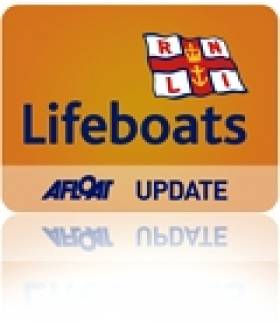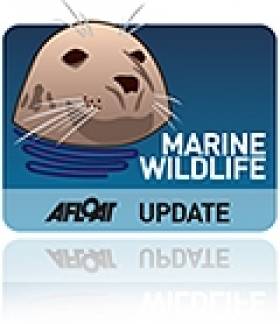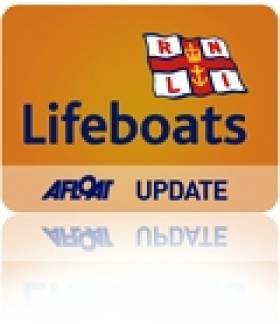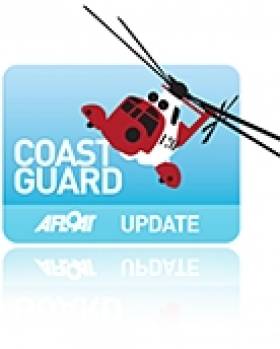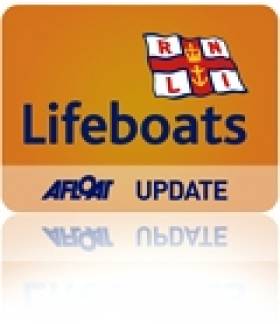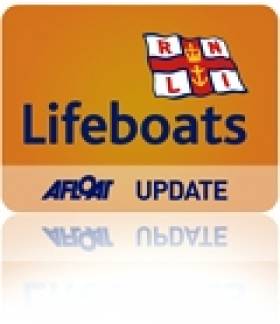Displaying items by tag: Portaferry
Four Calls In 24 Hours For Portaferry Lifeboat
#RNLI - The volunteer lifeboat crew at Portaferry RNLI responded to four separate calls in the space of 24 hours between Thursday 29 and Friday 30 May.
The first call was received at 6.07pm on Thursday to help four people on board a small powerboat with engine problems near Church Point in the Strangford Narrows area of Strangford Lough.
Weather at the time was cloudy with good visibility, a calm sea and Force 2 easterly winds. The volunteer crew launched at 6.13pm and were on scene with the two adults and two children onboard the powerboat within three minutes.
By this stage the people onboard the powerboat had managed to re-start their engine and made their way to the pontoons at Strangford. The RNLI crew made sure that everyone onboard the vessel was safely on shore before the volunteer lifeboat crew returned to station at Portaferry.
Not long after, a second call was received at 8.40pm from HM Coastguard requesting the RNLI to investigate a 10-metre yacht that appeared to have slipped its moorings and beached near the old Katherine Quay in Strangford, Co Down.
Once again, the weather was cloudy with good visibility, a calm sea and Force 1 easterly wind. The volunteer crew launched at 8.45pm and were on scene two minutes later, where they found two men on board and helped fix a line to secure the yacht so that it would not drift when the tide rose.
Once the yacht was secured, the lifeboat crew confirmed that the two men were happy to remain onboard while the lifeboat crew returned to station in Portaferry.
The third and final call of the evening was received 9.57pm from two men onboard another 10-metre yacht with engine problems some 10 miles south-east of the Strangford Bar at the mouth of Strangford Lough.
The two men had set out earlier that evening from Portaferry to travel to Peel Harbour in the Isle of Man. The volunteer crew launched at 10.02pm and reached the stricken yacht at 10.35pm.
Once the vessel was located, they put a lifeboat crew member on board and started to tow the vessel and its crew towards Peel Harbour in the Isle of Man, letting the larger all-weather lifeboat from Peel RNLI take over as they approached. The Portaferry crew departed the scene at 11.20pm.
The fourth call was received at 4.50pm on Friday, requesting the volunteer crew to go to the aid of six people, five in canoes and one in a small motorboat, who had got into difficulty just off Church Point.
The RNLI volunteers launched the lifeboat at 4.50pm and arrived at the scene five minutes later. Weather conditions were similar to Thursday, cloudy with good visibility, a calm sea and a Force 1 northerly wind.
On scene, the lifeboat crew discovered that the small motorboat had gone to help five adults in two canoes who were entering the Narrows area of Strangford Lough.
Having secured the two canoes, the motorboat itself started to experience engine problems, resulting in all three craft starting to drift towards the SeaGen tidal power turbine in the Narrows.
The volunteer lifeboat crew intercepted the six people at the Scotsman Rocks South, just south of Strangford, taking all on board the lifeboat, securing the small motorboat and two canoes and bringing all safely into Strangford Marina where they were put ashore.
#RNLI - Portaferry RNLI's volunteer lifeboat crew were involved in the rescue of 23 canoeists who got into difficulty just off Castle Island in Strangford Lough yesterday afternoon (Saturday 17 May).
The call for help was received at 2.40pm and the volunteer lifeboat crew launched at 2.45pm.
They arrived at the scene just off Castle Island in Strangford Lough in Co Down 10 minutes later, finding six of the party of canoeists in the water.
Weather conditions at the time were cloudy with good visibility, with a slight sea swell and a Force 4 southerly wind.
The RNLI crew recovered two of the people from the water, while a small motor boat which had also come to the canoeists' aid took the other four on board.
The RNLI lifeboat crew then took their two casualties along with two canoes back to nearby Strangford Lough Yacht Club, where the casualties were put ashore into the care of HM Coastguard.
- lifeboat crew then returned to the scene near Castle Island and from there escorted the remaining 17 members of the canoe party back to the safety of the yacht club.
Commenting on the rescue, Portaferry RNLI lifeboat operations manager Brian Bailie said: "Thankfully everyone was brought safely to shore and it is testament to the training and dedication of the volunteer RNLI crew that a potentially tragic situation was averted.
"Strangford Lough is an extremely popular location for groups of canoeists and it is vital that they take all necessary precautions when taking to the water."
#MarineWildlife - BBC News reports that Northern Ireland's Exploris aquarium will remain open for another two months as Ards Borough Council prepares to submit its business plan to save the facility in April.
As previously reported on Afloat.ie, the popular but loss-making tourist attraction was earmarked for closure last year - threatening the future of its more than 3,000 marine animals - but saved at the 11th hour, provided the council receives a one-off capital grant of more than €1 million from Stormont.
It's hoped that this funding would be confirmed and the aquarium will get the green light to remain operational when the NI Executive makes its decision on the plan.
That would mean Exploris could stay open for the peak spring/summer period, and close in October for a necessary six-month refurbishment over winter and next spring.
BBC News has more on the story HERE.
Portaferry Aquarium 'Saved' Pending £900k Govt Grant
#MarineWildlife - Northern Ireland's Exploris aquarium will be saved - provided the local council receives a one-off capital grant from Stormont.
BBC News reports that a new business plan to preserve the Portaferry aquarium, which is one of the North's biggest tourist attractions, has been agreed.
But the plan's success is subject to funding of £900,000 (€1.09 million) from the NI Executive as part of a financial rescue package for the facility.
Ards Borough Council, which has run the Co Antrim aquarium since its opening in 1987, says it can no longer afford its annual operating costs of some £500,000 (€600,000).
And its closure could see more than 3,000 marine animals presently housed in the facility destroyed.
Should the new funding be confirmed, Ards Borough Council would keep Exploris open for this year's peak spring/summer period before closing for a six-month refurbishment in the autumn.
The business plan for Exploris would also preserve the aquarium's seal sanctuary, although its own future was confirmed by Environment Minister Mark Durkan in November.
BBC News has more on the story HERE.
Fisherman Rescued By RNLI Crew Meets His Rescuers - And Owes His Life To Lifejacket Initiative
#RNLI - A fisherman whose boat sank in minutes has thanked several organisations who implemented and trained him on using a lifejacket for saving his life.
Samuel Cully, a fisherman from Portavogie, was in the water for 45 minutes after his vessel sank on Wednesday 18 September, off the coast of Co Down. Weather conditions at the time were rough seas with Force 5 to 6 winds blowing.
RNLI lifeboats from Portaferry and Donaghadee were launched within minutes of a May Day being received by the Belfast Coastguard, along with the Irish Coast Guard helicopter Rescue 116.
Recently Cully was reunited with the volunteer crew at Portaferry who rescued him.
Just weeks earlier, Cully had been provided with a personal flotation device in a grant-aided scheme run by the Fishermen’s Mission with funding and support from Seafish, the Department for Agriculture and Rural Development through the European Fisheries Fund, the Northern Ireland Fish Producers Organisation, RNLI, the Maritime Coastguard Agency and supermarket Asda.
The project aims to ensure that fishermen will receive a grant-aided PFD and the training required to ensure its proper use.
Frankie Horn, RNLI fishing safety manager for the UK and Ireland, said: "It’s great that Samuel is safe, and back with his family. We want fishermen to see the benefits of wearing a personal flotation device or lifejacket and for them to wear it voluntarily.
"This will be an ongoing process for us, talking to fishermen and working with the manufacturers to ensure that the PFDs provided are the best possible design for the fishing industry."
With the funding and logistics generously covered by other agencies, the RNLI was involved in leading the safety training session – an act that Cully is immensely grateful for.
"I was only able to swim five or ten metres or so, and even then the wind and swell were washing me away from the shore," he recalled. "The boat went down so quickly, and I was so relieved to find the lifejacket doing exactly what I was told it would do. I cannot thank all those organisations involved enough."
In more recent news, Donaghadee and Portaferry RNLI launched yesterday (Tuesday 8 October) to go to the aid of a man fishing off rocks who became stranded by the tide.
Belfast Coastguard had received a call from a member of the general public just after 10.20am alerting them of the emergency.
On arriving on the scene, Donaghadee's all-weather lifeboat crew found their colleagues from Portaferry RNLI's inshore lifeboat were taking the man off the rocks and returning him safely into Portavogie harbour.
Fisherman Rescued By Portaferry Lifeboat After Boat Capsizes off South Rock
#capsize – A man has been taken to hospital after his fishing boat capsized near South Rock, Northern Ireland.
Belfast Coastguard received a Mayday call at around 12:30pm today from the man on board the boat, who reported it was rapidly taking on water and sinking.
Belfast Coastguard repeatedly tried to get in touch with the vessel, but had no response.
They then sent the Irish Coast Guard Helicopter, RNLI Donaghadee Lifdboat, Portaferry RNLI Inshore Lifeboat, along with Coastguard Rescue Teams from Portaferry and Bangor, to his last reported position.
The man was spotted in the water and recovered by Portaferry Inshore Lifeboat. He was then winched onto the Coast Guard Helicopter and taken to the Royal Hospital, Belfast.
Ian Graham, Watch Manager at Belfast Coastguard, said: "We had to act quickly, with limited information, when we couldn't make further contact with the boat.
"Knowing the boat was taking on a lot of water, we sent several rescue units to make sure we could find the man as quickly as possible. Portaferry RNLI Inshore Lifeboat managed to pull the man out of the water, and he was then picked up by the Irish Coast Guard Helicopter who took him straight to hospital."
The Maritime and Coastguard Agency advises fishermen to make sure they're well prepared when heading out to sea, with as much life saving equipment on board as possible. This includes the necessary communications equipment, a liferaft, distress flares and personal flotation devices, which should be worn at all times whilst on deck.
The man was believed to be wearing a personal floatation device that was provided to him two weeks ago through a joint initiative by National Charity, the Fisherman's Mission, Seafish, the Department for Agriculture and Rural Development, through the European Fisheries Fund, and Asda.
Busy Weekend For Portaferry Lifeboat With Two Call-Outs
#RNLI - Portaferry RNLI had a busy start to the weekend with two call-outs last Friday (30 August).
The first call was received just before 3pm from a 5m Shetland open-top fishing vessel with two men and one child on board, who had lost power and run onto rocks near the entrance to Ardglass Harbour in Co Down.
The volunteer crew were on the water by 3.05pm and arrived on the scene 15 minutes later. Weather at the time was cloudy with good visibility and Force 4 northwest winds.
When the lifeboat crew arrived at the scene, the two men and the child had managed to climb onto the rocks to safety where they were met by a member of the coastguard.
The fishing vessel had lost power and by the time the crew could attempt to start the auxiliary engine the boat was washed onto the rocks. The lifeboat crew could do nothing to salvage the quickly sinking boat and remained at the scene until the two men and the child had been taken to safety.
The second call of the day was received at 9pm from a man and a teenager aboard a 27ft yacht that had lost engine power and was adrift close to the Fairway Buoy at the entrance to Strangford Lough in Co Down.
The volunteer crew launched at 9.07pm and were with the stricken yacht at 9.55pm after conducting a short search. The weather was fair with Force 4 to 5 northwest winds.
The lifeboat crew attached a line to the yacht and then proceeded to tow it nearly five miles to the safety of Portaferry Marina where they arrived at 11.20pm. The yacht was then securely moored in the marina and the two people on board safely put ashore.
Portaferry RNLI lifeboat operations manager Brian Bailie said: "It was certainly a busy start to the weekend for our volunteer crews and thankfully everyone was returned home safely.
"The skipper of the yacht which lost power at the mouth of Strangford Lough exercised good judgement calling for assistance when he did rather than attempting to sail back in what can be extremely tricky waters."
Aran Islands Lifeboat Launches To Grounded Yacht
#RNLI - Galway Bay FM reports that the Aran Islands RNLI lifeboat was tasked to assist a yacht that ran aground off Inis Mór in the Galway Bay island chain yesterday afternoon (23 August).
The yacht apparently got into difficulty in Killeany Bay while approaching Kilronan harbour, but the lifeboat crew soon helped it get on its way again, and all four people on board were safe and well.
Elsewhere, Portaferry RNLI was called out in the early hours of Thursday morning (22 August) to rescue two people stranded on an island at the north end of Strangford Lough.
The two adults, a man and a woman, had become stranded on Island Hill, a small island which lies just offshore in Strangford Lough between Newtownards and Comber in Co Down.
The island is accessible on foot at low tide via a concrete causeway connecting the mainland to the small island, but the couple had been cut off when the causeway became submerged due to the incoming tide.
Both were taken on board the lifeboat and taken to a nearby car park where they were they were passed into the care of the local coastguard.
Busy Weekend With Four Call-Outs For Portaferry RNLI
#RNLI - Portaferry RNLI in Co Down had a busy weekend with four separate call-outs over the two days.
The first came on Saturday 6 July following a report that three children were drifting offshore on an inflatable toy.
The volunteer lifeboat crew was already afloat on exercise as part of the annual raft race in Kircubbin, Co Down, when they got a call to go to the aid of the three children aged 10, 11 and 14 who were drifting out to sea on the inflatable 18 miles away at Cloughey Bay.
Thankfully by the time they arrived on scene a local coastguard unit had already attended and brought the three children to safety on shore.
Portaferry RNLI was called out for a second time at 4.10pm to rescue a number of people on board a speedboat that had lost power in Strangford Lough just off Killyleagh.
The crew arrived at the scene at 4.15pm, by which time the 15ft speedboat had already been towed in and was moored at the pontoons at Killyleagh Yacht Club in Strangford Lough.
On both occasions the weather was fine with good visibility and calm seas.
Yesterday (7 July) the volunteer crew launched for the third time to assist an injured woman on Salt Island in Strangford Lough.
The crew arrived at the island at 10.10am and assessed the situation before transporting two paramedics from Killyleagh to the injured woman, who was subsequently airlifted by Irish Coast Guard helicopter to Musgrave Park Hospital in Belfast for treatment.
At 11:35am, while returning to the lifeboat station, the crew was alerted once again, this time to go to the aid of two men onboard a five metre Dory that had lost power and was drifting just off Ringhaddy Sound in Strangford Lough.
The crew arrived on the scene at 12.05pm and took the men onboard the lifeboat, towing the powerless boat into Strangford Lough Yacht Club, where the men were then put ashore and their boat tied up.
Elsewhere in Northern Ireland, Newcastle RNLI assisted two men after their motor cruiser ran aground off the Co Down coast last Thursday (4 July).
The volunteer crew launched their inshore lifeboat at 2.20pm following a report from Belfast Coastguard that a small vessel had ran aground off Dundrum Bar with two people on board.
Weather conditions at the time were described as blowing south westerly four to five winds with moderate to choppy seas. There was good visibility.
The lifeboat, helmed by Nathan Leneghan and with crew members Declan Barry and Charles McClelland on board, arrived on scene at 2.30pm, where they observed that one of the men had made it to shore while the other was still on the 5m boat.
Speaking following the call-out, Newcastle RNLI deputy launching authority Joe McClelland said: "Thankfully, no one was in immediate danger and we were happy to bring the vessel and the man who was still on board safely to shore."
Portaferry RNLI Rescue Two Men In Drifting Dory
#RNLI - Portaferry RNLI launched on Saturday afternoon 15 June to go to the rescue of a small craft which had lost power in Strangford Lough, Co Down.
The volunteer lifeboat crew was alerted at 1.10pm following a call that there was a 5m Dory drifting after its engine had failed.
The lifeboat - helmed by Simon Rogers and with crew members George Toma, Brendan Byers and Ryan Kelly onboard - was launched at 1.20pm and was alongside the stricken vessel just off Gransha Point at 1.34pm.
The weather at the time was a slight swell, light winds and good visibility.
Once alongside, the lifeboat crew found that the Dory was taking on water. The two men were taken onboard the lifeboat and the Dory was towed into Strangford Lough Yacht Club where the men were also left off.


























